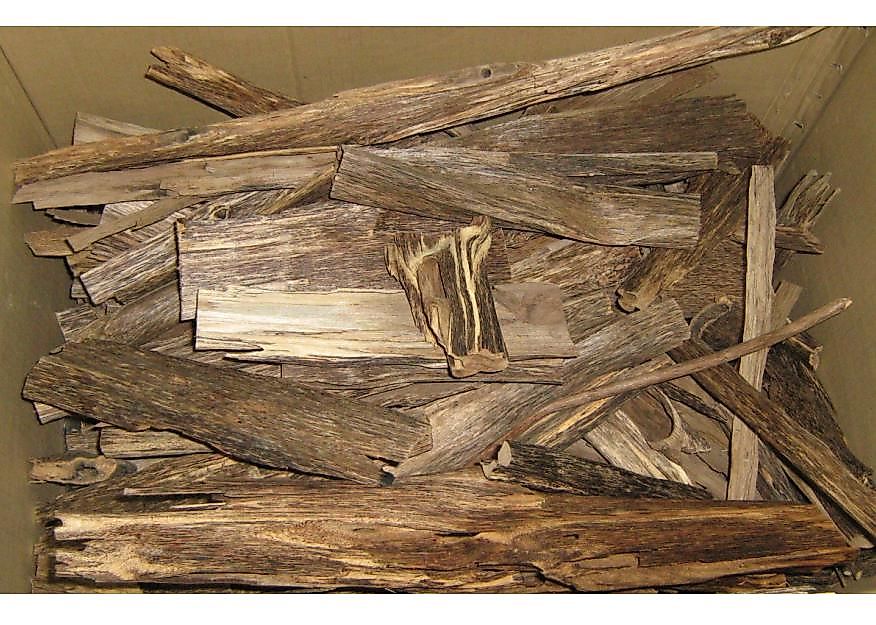Illegal Agarwood Seizures By Source And Destination Countries

Agarwood, also known as gaharu among other hosts of names is a resin embedded wood that forms in Gyrinops and Aquilaria trees when infected with certain mould. Before the infection the trees are odorless, light and pale colored bur as the infection progresses the tree begins to produce a dark aromatic resin. The wood is valued in many cultures for its distinctive fragrance thus it is used as a perfume and incense. Aquilaria trees are fast growing trees found mainly in lowland tropical forest.
The tree occurs naturally in South and Southeast Asia especially in the areas around Himalayas, North India, and Myanmar. Agarwood is relatively rare and cost high because of the significant depletion of the wild resource. Aquilaria, the source of agarwood, has been listed as an endangered species by Convention on International Trade in Endangered Species of World Flora and Fauna (CITES). Some of the top source and destination countries for illegal agarwood include Indonesia, Malaysia, India, and United Arab Emirates among others.
The Top Source And Destination Countries For Illegal Agarwood Seizures
Indonesia and Saudi Arabia
The demand for agarwood has led to persistent illegal trade threatening the future of the precious wood in Indonesia. Indonesia is one of the countries with the vast plantation of agarwood. Agarwood trade is also allowed in Indonesia mainly for the licensed traders making its exploitation very high. Between 2005 and 2014, 13 metric tons of illegal agarwood was seized in Indonesia. The demand for this wood comes from Saudi Arabia with 21.5 metric tons of illegally taken in the country. Saudi Arabia, oil extracted from agarwood is used to make oil and perfume. The agarwood oil has countless uses in Saudi Arabia including spiritual purposes, pain relief, and sex drive, treatment of digestive problems, skin toning and medicine for diseases such as epilepsy and liver conditions.
Malaysia and the United Arab Emirates
Malaysia is one of the countries that are more favorable for agarwood plantation. Malaysians cut down agarwood indiscriminately leading to a significant reduction in the tree population. Agarwood harvesting is illegal in Malaysia, but the harvesting still continues. Agarwood is harvested to a great quantity in Malaysia because of its high market value. Illegal harvesters access the protected areas and stay there for an extended period logging and hunting other wild animals. Between 2005 and 2014 a total of 7 metric tons of illegal agarwood was seized in the country. The illegal wood is mainly shipped to UAE where its demand is very high. 5.3 metric tons of illegal were seized in UAE between 2005 and 2014. However, the country is not limited from importing the wood. In UAE agarwood is used for making oud oil used as traditional aromatic and perfume. Agarwood chips are also burnt in homes to honor guests and perfume homes and garments for special occasions.
The Need To Stop The Illegal Trade In Agarwood
India and United Arab Emirates are also some of the countries where significant metric tons of illegal agarwood have been seized between 2005 and 2014. The majority of the agarwood seized were destined for US and Japan. UAE and Japan are the largest markets for agarwood in the world. The tree has been listed CITES because of its high demand and could easily be threatened with overharvesting. Therefore it is monitored in all countries around the world.
The Top Source And Destination Countries For Illegal Agarwood Seizures
| Rank | Source Country | Volume of illegal agarwood trade seizures 2005 to 2014 (in metric tons) | Destination Country | Volume of illegal agarwood trade seizures 2005 to 2014 (in metric tons) |
|---|---|---|---|---|
| 1 | Indonesia | 13 | Saudi Arabia | 21.5 |
| 2 | Malaysia | 7 | United Arab Emirates | 5.3 |
| 3 | India | 7 | United States | 1.4 |
| 4 | United Arab Emirates | 5 | Japan | 0.4 |
| 5 | Others | 2 | Others | 0.1 |











